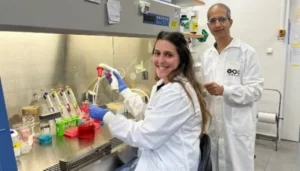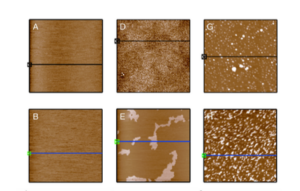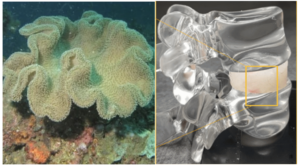Technion (Israël) : créer de l'énergie par photosynthèse et respiration cellulaire

[:fr]
Des chercheurs en chimie de l’institut de technologie Technion en Israël ont découvert que la composition de la membrane cellulaire avait une incidence sur les processus de production d’énergie par la photosynthèse et la respiration cellulaire.

Le professeur assistant Nadav Amdursky de la faculté de chimie Schulich du Technion a mis au point une technologie permettant d’étudier les transitions membranaires des protons liées à la production d’énergie dans les processus de respiration cellulaire et de photosynthèse.
L’énergie est une ressource essentielle dans le monde animal, sans laquelle il ne peut y avoir de vie. Tous les animaux et toutes les plantes utilisent le même type d’énergie, la molécule d’adénosine triphosphate (ATP) – un nucléotide connu en biochimie comme la «monnaie moléculaire», capable de stocker et de transporter de l’énergie chimique dans les cellules. La synthèse de l’ATP a lieu pendant les processus de photosynthèse ou de respiration cellulaire, où l’énergie de la lumière du soleil ou l’énergie chimique des nutriments, respectivement, sont utilisées pour la production d’ATP. Le mécanisme moléculaire de la synthèse de l’ATP repose sur une protéine membranaire. L’activité de la protéine peut être liée à l’action d’un moteur nanométrique alimenté par des protons. Lorsque le moteur reçoit de l’essence – des protons – les parties protéiques bougent.
L’action générale de ce moteur protéique est de créer de l’ATP. Mais comment les protons atteignent-ils la protéine ? Cette question n’a pas encore été entièrement résolue, car l’étendue du processus de déplacement des protons dans le temps et dans l’espace est infime ; quelques nanomètres toutes les quelques nanosecondes.
La technologie mise au point par Nadav Amdursky pour étudier ce processus minuscule et rapide se déroule à la surface des membranes et repose sur une sonde moléculaire originale qui se fixe à la membrane et libère un proton chaque fois que la lumière (photons) la frappe.

« En d’autres termes, il s’agit d’une technologie capable de produire le carburant nécessaire à la création d’une monnaie énergétique à la surface des membranes à l’aide de la lumière », explique Muriel Touaty, Directrice générale du Technion France.
La sonde moléculaire développée au Technion est basée sur une molécule chimique très intrigante appelée photo-acide. Lorsque cette molécule absorbe la lumière – et seulement alors – ses propriétés chimiques changent et devient un acide fort. La principale caractéristique de tout acide fort est la libération rapide d’un proton dans un environnement aqueux, et c’est ce qui se produit également ici.
«Nous avons découvert que le mouvement des protons à la surface de la membrane et l’interaction entre les protons de la membrane et les protons de la solution dépendaient étroitement du type de lipides constituant la membrane», a déclaré le Pr Amdursky. « Cette recherche est une étape clé dans la compréhension d’un des processus les plus importants de la nature ».
Une simulation informatique (dynamique moléculaire) montrant l’emplacement de la sonde moléculaire à la surface de différentes membranes avec différentes compositions lipidiques.
L’étude, menée avec des collaborateurs britanniques et finlandais, a été publiée sous le titre « Exploration des événements de transfert rapide de protons associés à la diffusion latérale des protons à la surface des membranes».
La recherche a été financée par la Chaya Career Advancing Chair, le Russell Berrie Nanotechnology Institute et le programme Grand Technion Energy.
Publication dans PNAS, 12 février 2019
[:en]
Innovative Technion Technology Will Advance Research of Energy Production by Photosynthesis and Cellular Respiration
Chemistry researchers at the Technion-Israel Institute of Technology have discovered that processes related to producing energy by photosynthesis and cell respiration are affected by the composition of the cell membrane.

Assistant Professor Nadav Amdursky of the Technion’s Schulich Faculty of Chemistry has developed a technology for the study of membrane proton transitions related to the production of energy in cellular respiration and photosynthesis processes. The study, conducted with collaborators from the UK and Finland, was recently published in the Proceedings of the American Academy of Sciences (PNAS) with the title “Exploring fast proton transfer events associated with lateral proton diffusion on the surface of membranes.”
Energy is an essential resource in the animal world, without which there can be no life. All animals and plants use the same type of energy, the adenosine triphosphate (ATP) molecule – a nucleotide known in biochemistry as the “molecular currency”, able to store and transport chemical energy within cells. The synthesis of ATP takes place during the photosynthesis or the cellular respiration processes, where the energy of sunlight or chemical energy of nutrients, respectively, is used for the production of ATP. The molecular mechanism for ATP synthesis is based on a membrane protein. The protein’s activity can be linked to the action of a nanometer motor powered by protons. When the engine gets fuel – protons – the protein parts move.
The general action of this protein engine is to create ATP. But how do the protons reach the protein? This question has not yet been fully resolved, because the scope of the proton-movement process in time and space is tiny; a few nanometers every few nanoseconds.
The technology developed by Assistant Prof. Amdursky to study this tiny and fast process occurs on the surface of membranes, and is based on an original molecular probe that attaches to the membrane and releases a proton whenever light (photons) hits it. In other words, it is a technology that can produce the fuel to create the energy “currency” on the surface of membranes with the help of light.
The molecular probe developed at the Technion is based on a very intriguing chemical molecule called photo-acid. When this molecule absorbs light – and only then – its chemical properties change, and it becomes a strong acid. The main characteristic of any strong acid is the speedy release of a proton in an aqueous environment, and this is what happens here as well.
“We discovered that the movement of protons on the surface of the membrane and the interaction between protons on the membrane and protons in the solution are closely dependent on the type of lipids that make up the membrane,” said Prof. Amdursky. “This research is a key step in understanding one of the most important processes in nature.”
Published on PNAS,
The research was supported by the Chaya Career Advancing Chair, the Russell Berrie Nanotechnology Institute, and the Grand Technion Energy Program.
[:]







